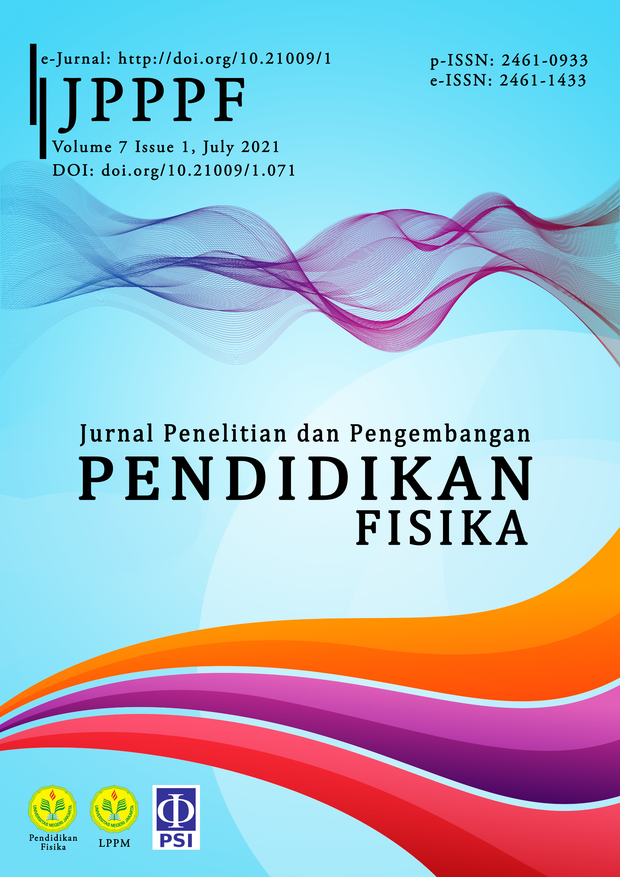Virtual Reality Technology in Physics Learning: Possibility, Trend, and Tools
DOI:
https://doi.org/10.21009/1.07103Keywords:
instructional design, immersive technology, systematic literature reviewAbstract
This study aims to disclose how virtual reality technology has been applied to studies of learning and the possibility of virtual reality by reviewing studies that have employed the virtual reality approach. A total of 15 papers were selected from the Scopus Index database from 2015 to 2020. Content analysis showed that virtual reality and physics learning had received the most attention under the theme of student perception, especially in self-efficacy and experience, followed by satisfaction, motivation, and engagement. Trends of research development show that the use of virtual reality has proliferated recently. Moreover, HTC Vive is the most powerful device to conduct the VR study for the tool device. This study concludes that virtual reality technology provides a promising media for educational researchers.
References
Anita, A, & Novianty, F. 2020 ‘The Students’ Characters Analysis in Physics Learning Process’, Jurnal Penelitian & Pengembangan Pendidikan Fisika, vol. 6, no. 1, pp. 75-80.
Arias, S, La Mendola, S, Wahlqvist, J, Rios, O, Nilsson, D, & Ronchi, E. 2019, ‘Virtual Reality Evacuation Experiments on Way-Finding Systems for the Future Circular Collider’, Fire Technology, vol. 55, no. 6, pp. 2319–2340.
Borrego, M, Foster, MJ, & Froyd, JE. 2014, ‘Systematic Literature Reviews in Engineering Education and Other Developing Interdisciplinary Fields’, Journal of Engineering Education, John Wiley & Sons, Ltd, vol. 103, no. 1, pp. 45–76.
Chamilothori, K, Wienold, J, & Andersen, M. 2019, ‘Adequacy of Immersive Virtual Reality for the Perception of Daylit Spaces: Comparison of Real and Virtual Environments’, LEUKOS - Journal of Illuminating Engineering Society of North America, vol. 15, no. 2–3, pp. 203–226.
Chang, SC, Hsu, TC, Chen, YN, & Jong, MS yung. 2020, ‘The effects of spherical video-based virtual reality implementation on students’ natural science learning effectiveness’, Interactive Learning Environments, vol. 28, no. 7, pp. 915–929.
Dick, W & Johnson, RB. 2002, ‘Evaluation in instructional design: The impact of Kirkpatrick’s four-level model’, Trends and Issues in Instructional Design and Technology, pp. 145–153.
Georgiou, J, Dimitropoulos, K, & Manitsaris, A. 2007, ‘A virtual reality laboratory for distance education in chemistry’, International Journal of Social Sciences, vol. 2, no. 1, pp. 34–41.
Greenwald, SW, Corning, W, Funk, M, & Maes, P. 2018, ‘Comparing learning in virtual reality with learning on a 2D screen using electrostatics activities’, Journal of Universal Computer Science, vol. 24, no. 2, pp. 220–245.
Hamilton, D, McKechnie, J, Edgerton, E, & Wilson C. 2021 ‘Immersive virtual reality as a pedagogical tool in education: a systematic literature review of quantitative learning outcomes and experimental design’, J. Comput. Educ, vol. 8, pp. 1–32.
Harzing, AW. 2007, Publish or Perish, available at: https://harzing.com/resources/publish-or-perish.
Kersting, M, Steier, R, & Venville, G. 2021, ‘Exploring participant engagement during an astrophysics virtual reality experience at a science festival’, International Journal of Science Education, vol. 11, pp. 17–34.
Kirkpatrick, D. 1996, ‘Great ideas revisited’, Training & Development, vol. 50, no. 1, pp. 54–60.
Lamb, R, Antonenko, P, Etopio, E, & Seccia, A. 2018, ‘Comparison of virtual reality and hands on activities in science education via functional near infrared spectroscopy’, Computers and Education, vol. 124, pp. 14–26.
Liu, R, Wang, L, Lei, J, Wang, Q, & Ren, Y. 2020, ‘Effects of an immersive virtual reality-based classroom on students’ learning performance in science lessons’, British Journal of Educational Technology, vol. 51, no. 6, pp. 2034–2049.
Makransky, G, Mayer, RE, Veitch, N, Hood, M, Christensen, KB, & Gadegaard, H. 2019, ‘Equivalence of using a desktop virtual reality science simulation at home and in class’, PLoS ONE, vol. 14, no. 4, pp. 1–14.
Makransky, G, Petersen, GB, & Klingenberg, S. 2020, ‘Can an immersive virtual reality simulation increase students’ interest and career aspirations in science?’, British Journal of Educational Technology, vol. 51, no. 6, pp. 2079–2097.
Makransky, G, Terkildsen, TS, & Mayer, RE. 2019, ‘Adding immersive virtual reality to a science lab simulation causes more presence but less learning’, Learning and Instruction, vol. 60, pp. 225–236.
O’Connor, M, Deeks, HM, Dawn, E, Metatla, O, Roudaut, A, Sutton, M, Glowacki, BR, et al. 2018, ‘Sampling molecular conformations and dynamics in a multi-user virtual reality framework’, Science Adcanves, vol. 4, no. 6, pp. 1–9.
Pirker, J, Lesjak, I, Parger, M, & Gütl, C. 2018, ‘An educational physics laboratory in mobile versus room scale virtual reality - A comparative study’, Lecture Notes in Networks and Systems, vol. 22, pp. 1029–1043.
Porter, CD, Smith, JRH, Stagar, EM, Simmons, A, Nieberding, M, Orban, CM, Brown, J, et al. 2020, ‘Using virtual reality in electrostatics instruction: The impact of training’, Physical Review Physics Education Research, vol. 16, no. 2, pp. 020119.1-020119.9.
Šiđanin, P, Plavšić, J, Arsenić, I, & Krmar, M. 2020, ‘Virtual reality (VR) simulation of a nuclear physics laboratory exercise’, European Journal of Physics, vol. 41, no. 6, pp. 065802.1–065802.12.
Tsivitanidou, OE, Georgiou, Y, & Ioannou, A. 2021 ‘A Learning Experience in Inquiry-Based Physics with Immersive Virtual Reality: Student Perceptions and an Interaction Effect Between Conceptual Gains and Attitudinal Profiles’, J Sci Educ Technol, 25 June 2021.











